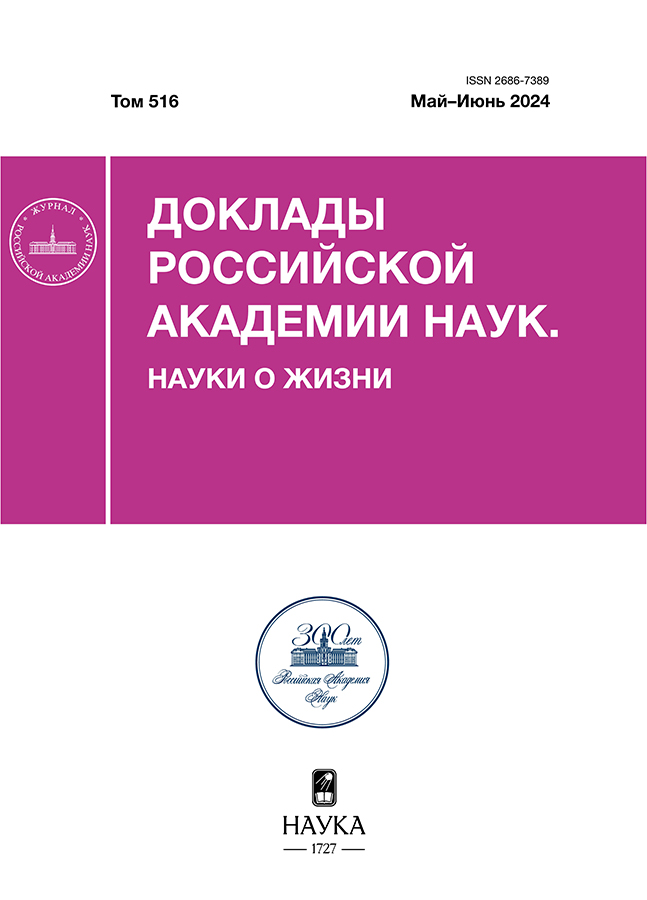Membrane-bound ferriform hemoglobin in nuclear erythrocytes of the sea ruff (Scorpaena porcus, Linnaeus, 1758)
- Autores: Soldatov A.A.1,2, Shalagina N.E.1, Rychkova V.N.1, Kukhareva T.A.1
-
Afiliações:
- A.O. Kovalevsky Institute of Biology of the South Seas of the Russian Academy of Sciences
- Sevastopol State University
- Edição: Volume 516, Nº 1 (2024)
- Páginas: 34-39
- Seção: Articles
- URL: https://cijournal.ru/2686-7389/article/view/651427
- DOI: https://doi.org/10.31857/S2686738924030065
- EDN: https://elibrary.ru/VUBDLE
- ID: 651427
Citar
Texto integral
Resumo
The content of the membrane-bound methemoglobin fraction (MtHb) in the nuclear erythrocytes of the sea ruff (Scorpaena porcus, Linnaeus, 1758) was studied in vitro. The spectral characteristics of whole hemolysate, hemolysate after stroma deposition (purified hemolysate), and resuspended stroma were studied. It was found that the proportion of MtHb in the stroma of erythrocytes exceeded 80% (6.20 ± 0.59 µM). The purified hemolysates practically did not contain MtHb (0.5 ± 0.2 µM). The presence of a membrane-bound ferriform did not affect the resistance of erythrocytes to osmotic shock. The osmotic resistance limits determined using the LaSca-TM microparticle laser analyzer (BioMedSystems, Russia) (102–136 mOsm kg–1) coincided with those noted for other bony fish species. The nitrite load (10 mg l–1) caused a significant increase in the MtHb content in the blood. However, the level of the membrane-bound ferriform did not change significantly and amounted to 6.34 ± 1.09 µM (about 95%). This indicates the functional expediency of its presence in this structure. The presence of MtHb in the cytoplasmic membrane of nuclear erythrocytes, apparently, allows cells to neutralize the external oxidative load and the toxic effect of hydrogen sulfide in the bottom layers of water in which the sea ruff lives.
Palavras-chave
Texto integral
Sobre autores
A. Soldatov
A.O. Kovalevsky Institute of Biology of the South Seas of the Russian Academy of Sciences; Sevastopol State University
Autor responsável pela correspondência
Email: alekssoldatov@yandex.ru
Rússia, Sevastopol; Sevastopol
N. Shalagina
A.O. Kovalevsky Institute of Biology of the South Seas of the Russian Academy of Sciences
Email: alekssoldatov@yandex.ru
Rússia, Sevastopol
V. Rychkova
A.O. Kovalevsky Institute of Biology of the South Seas of the Russian Academy of Sciences
Email: alekssoldatov@yandex.ru
Rússia, Sevastopol
T. Kukhareva
A.O. Kovalevsky Institute of Biology of the South Seas of the Russian Academy of Sciences
Email: alekssoldatov@yandex.ru
Rússia, Sevastopol
Bibliografia
- Maestre R., Pazos M., Medina I. Involvement of Methemoglobin (MetHb) Formation and Hemin Loss in the Pro-oxidant Activity of Fish Hemoglobins // J. Agric. Food Chem. 2009. V. 57. № 15. P. 7013–7021.
- Jensen F.B., Nielsen K. Methemoglobin Reductase Activity in Intact Fish Red Blood Cells // Comp. Biochem. Physiol. Part A: Mol. & Integ. Physiol. 2018. V. 216. P. 14–19.
- Woo S.P.S., Liu W., Au D.W.T., et al. Antioxidant Responses and Lipid Peroxidation in Gills and Erythrocytes of Fish (Rhabdosarga Sarba) upon Exposure to Chattonella Marina and Hydrogen Peroxide: Implications on the Cause of Fish Kills // J. Exp. Mar. Biol. Ecol. 2006. V. 336. P. 230–241.
- Hardig J., Hoglund L. B. Seasonal and Ontogenetic Effects on Methaemoglobin and Reduced Glutathione Contents in the Blood of Reared Baltic Salmon // Comp. Biochem. Physiol. 1983. V. 76A. № 1. P. 27–34.
- Welbourn E.M., Wilson M.T., Yusof A., et al. The Mechanism of Formation, Structure and Physiological Relevance of Covalent Hemoglobin Attachment to the Erythrocyte Membrane // Free Rad. Biol. Med. 2017. V. 103. P. 95–106.
- Sztiller M., Puchala M., Kowalczyk A., et al. The Influence of Ferrylhemoglobin and Methemoglobin on the Human Erythrocyte Membrane // Red. Rep. 2006. V. 11. № 6. P. 263–271.
- Soldatov A.A. Physiological Aspects of Effects of Urethane Anesthesia on the Organism of Marine Fishes // Hydrobiol. J. 2005. V. 41. № 1. P. 113–126.
- Tiihonen K., Nikinmaa M. Short Communication Substrate Utilization by Carp (Cyprinus Carpio) Erythrocytes // J. Exp. Biol. 1991. V. 161. № 1. P. 509–514.
- Benesch R.E., Benesch R., Yung S. Equations for the Spectrophotometric Analysis of Hemoglobin Mixtures // Anal. Biochem. 1973. V. 55. P. 245–248.
- Chu H., Breite A., Ciraolo P., et al. Characterization of the Deoxyhemoglobin Binding Site on Human Erythrocyte Band 3: Implications for O2 Regulation of Erythrocyte Properties // Blood. 2008. V. 111. P. 932–938.
- Sega M.F., Chu H., Christian J., et al. Interaction of Deoxyhemoglobin with the Cytoplasmic Domain of Murine Erythrocyte Band 3 // Biochem. 2012. V. 51. P. 3264–3272.
- Rifkind J.M., Nagababu E. Hemoglobin Redox Reactions and Red Blood Cell Aging // Antioxidants & Redox Signaling. 2013. V. 18. P. 2274–2283.
- Demehin A.A., Abugo O.O., Jayakumar J.R., et al. Binding of Hemoglobin to Red Cell Membranes with Eosin-5-Maleimide-Labeled Band 3: Analysis of Centrifugation and Fluorescence Data // Biochem. 2002. V. 41. P. 8630–8637.
- Nagababu E., Mohanty J.G., Bhamidipaty S., et al. Role of Membrane in the Formation of Heme Degradation Products in Red Blood Cells // Life Sci. 2010. V. 86. P. 133–138.
- Salhany J.M. Kinetics of Reaction of Nitrite with Deoxy Hemoglobin after Rapid Deoxygenation or Predeoxygenation by Dithionite Measured in Solution and Bound to the Cytoplasmic Domain of Band 3 (SLC4A1) // Biochemistry. 2008. V. 47. P. 6059–6072.
- Saleh M.C., McConkey S. NADH-dependent Cytochrome b5 Reductase and NADPH Methemoglobin Reductase Activity in the Erythrocytes of Oncorhynchus Mykiss // Fish Physiol. Biochem. 2012. V. 38. P. 1807–1813.
- Cooper C.E., Brown G.C. The Inhibition of Mitochondrial Cytochrome Oxidase by the Gases Carbon Monoxide, Nitric Oxide, Hydrogen Cyanide and Hydrogen Sulfide: Chemical Mechanism and Physiological Significance // J. Bioenerg. Biomembr. 2008. V. 40. P. 533–539.
- Bagarinao T. Sulfide as an Environmental Factor and Toxicant: Tolerance and Adaptations in Aquatic Organisms // Aquat. Toxicol. 1992. V. 24. P. 21–62.
- Wu B., Teng H., Yang G. Hydrogen Sulfide Inhibits the Translational Expression of Hypoxia-inducible Factor-1α // Br. J. Pharmacol. 2012. V. 167. P. 1492–1505.
- Jensen B., Fago A. A Novel Possible Role for Met Hemoglobin as Carrier of Hydrogen Sulfide in the Blood // Antioxidants & Redox Signaling. 2020. V. 32. № 4. P. 258– 265.
Arquivos suplementares














